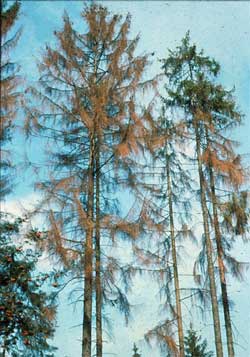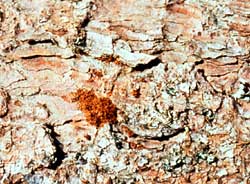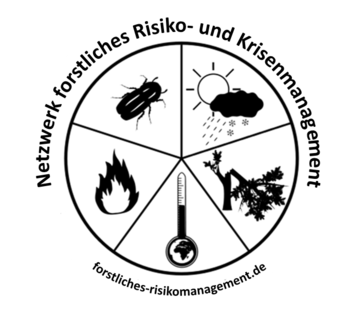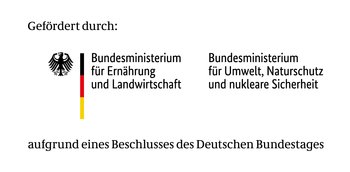Prevention in years without outbreaks and large-scale calamities
The most effective way of reducing bark beetle damage to conifers, especially from the larger (Ips typographus) and smaller European spruce bark beetles (Pityogenes chalcographus) is "clean" forest practises. This means comprehensive removal of all potential breeding ground material from the forest.
- Salvage logging of infested, diseased or dying trees
- Salvage logging of trees damaged by storms or snow
- Dispatching timber while it is still cold (October to March) before spring time flights
- Speedy removal of timber from the forest or
- immediate debarking of the logs or
- in extreme cases preventive application of an approved plant protective agent during summer months (April to September) outside of the stand
Prevention of outbreaks after calamities
Experiences during previous salvage logging operations showed that prevention of wood-boring and bark beetle infestation must start when logging damaged trees. Due to its high proportion in windblown trees and its high potential risk from Ips typographus, the main focus of preventive measures is spruce. After calamities, the local conditions must be surveyed carefully and then the damaged areas prioritised. This will determine which areas must be logged at once and which areas can be left unprocessed for the time being due to low potential risk of infestation (see Life Conservation).
Order of logging

Pic. 1: Infested spruce trees, offspring have already flown.

Pic. 2: Bark with bore dust, a definite sign of infestation. Speedy salvage logging is necessary! (Photos: H-J. Schröter)
- Process spruce trees before other conifers.
- Clean up smaller (up to 2 ha) windblown sites before large ones. The potential risk in relation to the timber volume is higher the smaller the area. Infestation of windblown timber proceeds much quicker, sharply increasing the risk of infestation into adjacent, standing trees.
- Clear sites with high proportions of broken trees before predominantly windblown sites.
- Process single thrown or broken trees (concentrated app. 40 m³/ha) before large windthrown areas.
- Process damaged stands which have large diameter trees (> 20 cm DBH) before stands with mainly small-sized trees.
- Clear hillside situations (especially Southern slopes) before plateaus.
Further measures:
- Speedy clearance of vulnerable stands (but progress must be geared to bottlenecks in skidding, transportation or storage capacities).
- Removal of logs as soon as possible after primary conversion (selling or conserving in wet storage). Long periods of interim storage on roadsides leads to problems with forest and wood protection.
- Debarking of logs (NB: not a protection against timber beetles!)
- Interim storage outside the forest. 500 (-1,000) m minimum distance to vulnerable stands.
- Continuous checking of vulnerable stands for beetle infestation, immediate salvage logging if required. Disposal of slash by burning, chipping or mulching is only recommended on small sites posing a high potential risk to adjacent stands and if sufficient capacities are available. Apply soil-conserving methods and try to keep the forest fire hazard low.
- Cut unsplit stumps (> 20 cm DBH, > 3 m height) on sites with high proportions of broken trees. They can act as wood and bark boring beetle reservoirs for a long time.
Monitoring and infestation checks
Failure to carry out spring checks properly will have consequences throughout the whole year. Capacities will then be bound continuously to salvage logging in stands with advanced infestations, and the logging of newly infested stands will have to be postponed.
In principle, the most favourable conditions for infestation checks during the first year after a storm are provided in May/June. The spatial distribution of infestation hotspots is then still closely bound to windblown sites and therefore foreseeable to a considerable extent. This correlation will constantly decrease over the following years.
Some bark beetles can, at a given population density, infest and kill trees irrespective of the tree’s health and vitality. Population control and reduction have the highest priority here. Trap-monitoring and infestation checks are the basis of effective beetle control with a strategy adapted to local conditions.
- Monitoring of the swarming progress of Ips typographus with a few pheromone trap lines per forest district. Every district with high proportions of spruce should be well-informed about local swarming progress relating to altitude. However, the method is not suited for properly projecting spatial risk hotspots within a district.
- Results of checking infestation activities in the stands are the basis for planning and carrying out countermeasures.
- Systematic and regular checking should be based on a map showing infested stands and those at high risk. These stands can then be checked continually. Results of checking should be documented in the maps. Infestations should also be marked visibly in the forest.
Systematic checking of standing infested trees in particular should be a high priority in the year following a storm. The time between infestation and removal/decontamination of such trees must be kept as short as possible. Advantages of early conversion of still green-topped trees compared to red-topped trees (6-8 weeks after infestation, discoloured crown, needles falling, young beetle stage or later) are:
- Longer time period to redirect capacities at short notice (Supplementation, concentration and coordination of logging, skidding, transportation and debarking capacities).
- This can help minimise insecticide application. Faster response at higher altitudes is possible: compared to lower altitudes, infestation develops faster than the reddening treetops indicate.
- During the early beetle stage, a lot of bark falls off the stem. This contains a considerable proportion of the brood, which will then remain on-site even when the infested trees are logged. This effect is less severe during the larval stage, as the bark is still more adherent.
- Timber from early detected and converted infested trees is still high-grade. This can help maintain the market and be used as an argument for timely and reliable timber removal.
- Accruing timber can be marketed over a longer period, reducing the extent to which the timber market is flooded in July/August.
Monitoring infestations/ diagnosis
| Infestation indicators | Symptoms | Comments |
| Bark damage by woodpeckers | Bright spots on infested trees and healthy neighbouring trees, caused by woodpeckers searching for insects under the bark and the dropping off of larger bark segments. | Early sign of infestation. |
| Bore dust | Brown bore dust on bark, in cobwebs, on ground vegetation. | Most definite indicator during the first three weeks of infestation. Fighting the population is most successful at this stage. Attention: Bore dust can be blown away by wind or washed off by rain and thus might be missing on infested trees. |
| Bore holes and needles, possibly resin droplets and resin flow at the trunk (base of crown) | After the bore dust is gone, the only signs of infestation over the next 3-4 weeks are bore holes and minor needle losses. | Infestation is very difficult to detect. |
| Reddening and dropping off of needles, red-top, characteristic gallery systems under the bark | It is already too late for fast action. The offspring have flown by the time the infestation becomes so obvious. | |
| Infestation by sister brood: Mid- to end of June, first discolouration visible by mid-August, obvious discolouration end of August. |
The only chance to detect infestation in standing trees before the beetles fly is looking for bore dust!
When?
- Start searching in spring after the first swarming flight;
- keep searching once a week or fortnight, depending on risk level.
- Attention: Bore dust might be blown away by strong winds or washed away by rain!
Where?
- Especially in areas where infestations occurred during previous years, on Southern slopes and opened forest edges.
- Edges of windthrow and snow damage sites are particularly at risk.
- All spruce stands older than approx. 40 years are susceptible to Ips typographus and must be checked when this risk level is reached.
How?
- Individual checks, tree by tree. Marking infestations on a stand map is useful for documentation purposes and for checks in following years. Infested trees should be marked directly as well.
Active control
- During larval/pupa stage: log and remove or debark infested trees as quickly as possible.
- Disposal of infested bark (debarker with baffle plate, burning of bark or filling in bags, apply insecticide to bark heaps outside the stand, etc.).
- Move timber to a safe place, e.g. directly to the sawmill or to an interim storage site outside the forest (minimum distance to the next conifer stand 500 m).
- If the risk to remaining stands is – after applying all other control measures – still very high, insecticide application to infested stems should be arranged (consider certification regulations!). The logs should be stacked along the forest road or at least at the skidding track to protect the ecosystem from a large area application. Thorough application of appropriate amounts during the early stages of infestation can help lower the overall amount of insecticides needed in the long run.
- Local use of pheromone traps to lower infestation pressure from Ips typographus to vulnerable stand edges (protection of individual objects) can only be recommended where present infestations are small-scale. The benefits of pheromone traps on large-scale infestation sites are disproportionate to the required time and effort.
Further instructions
- Infested trees showing only the "white" stages (larva/pupa) can only be found during the first 6-8 weeks after the main infestation period in spring. Throughout the rest of the beetle season, "white" stages will very often be found on one tree together with adult beetle stages. It is highly recommended to dispose of the bark after debarking during this time, either by burning or by applying insecticides to bark heaps. Application of insecticides to bark heaps will at least reduce the amount of insecticides needed compared to application to logs over bark on stacks, (if insecticides are the only option for the forest enterprise).
- Creation of a buffer area by cutting uninfested but susceptible trees around an infested area will not be successful after calamities and is therefore not recommended. It is instead necessary to log the infested trees and continue checking the site regularly for new infestations. Binoculars can be used to check trees in the immediate vicinity for resin droplets, bore dust or needle loss.
| Aims | Basics | |
| ‘Clean’ forestry practise | Prevention by removal of breeding grounds |
|
| Infestation checks | Basis for planning countermeasures |
|
| Removal of infested material | Reduction of beetle density and /or protection of imminently vulnerable stands (protection of individual objects) |
|
Pheromone traps | Monitoring or protection of imminently vulnerable stands (protection of individual objects) |
|
| Insecticides | Protection of adjacent susceptible stands at imminent risk of infestation |
|
| Short overview ‘Integrated Forest Protection’ against bark beetles, esp. Ips typographus. |
Downloads (in german)
- Kurzcheckliste Waldschutz (PDF-Datei, 22 KB)
- Kurzmerkblatt Waldschutzmaßnahmen gegen Rindenbrüter (PDF-Datei, 90 KB)
- Handlungsempfehlungen bei drohender Borkenkäferkalamität für Rheinland-Pfalz (PDF-Datei, 48 KB)
- Steckbrief Fichtenborkenkäfer (PDF-Datei, 191 KB)
- Steckbrief Lärchenborkenkäfer (PDF-Datei, 195 KB)
- Steckbrief Kiefernborkenkäfer (PDF-Datei, 331 KB)
- Steckbrief Tannenborkenkäfer (PDF-Datei, 416 KB)
- Steckbrief Eichenprachtkäfer (PDF-Datei, 177 KB)
- Entrindung von befallenem Stammholz (PDF-Datei, 93 KB)
Forest Crises Management Advisory Guide
Back to the main page of the Forestry Crisis Management Advisor Guide: Overview of the different topic collections
Back to the article overview in the: Storm Topic Collection – Coping with Storm Damaged Timber


